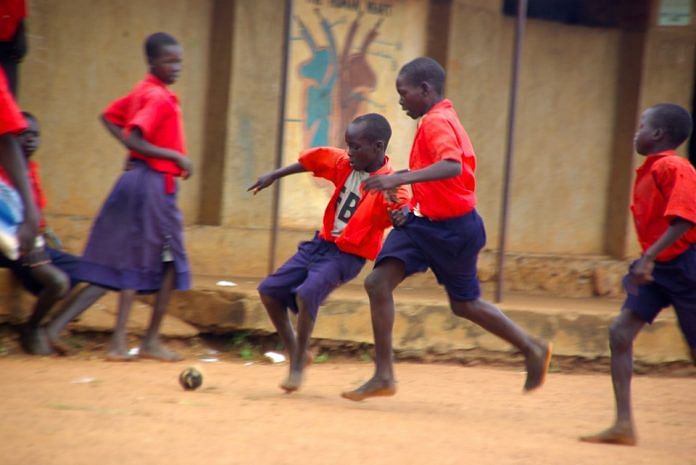A society of wildlife conservation is using football and naming teams after local animals, to foster affinity for wildlife in the African nation of Cameroon.
A whistle blows and young men in brightly coloured jerseys race towards a football on a grassy field in Erat, a community that lies within the boundaries of Korup National Park in southwest Cameroon.
It might be hard to believe, but this is an excellent example of community-based wildlife conservation in action.
Increasingly, conservation organisations around the world are using sporting events to help promote conservation awareness, encourage wildlife and environmental stewardship practices and foster positive relationships among community, government and non-profit organisations.
One such example is Korup Rainforest Conservation Society (KRCS) in southwest Cameroon’s Korup National Park, an area rich in biodiversity and human culture. It is home to Preuss’s red colobus monkey (Piliocolobus preussi), drill (Mandrillus leucophaeus), pangolin species and forest elephants (Loxodonta cyclotis).
But there is also conflict, including direct human-wildlife conflict from crop-raiding wildlife, human safety risks and human-human conflict between those who harvest bushmeat for sustenance or illegal trade.
Local wildlife teams
Conservation concerns are typically addressed with more traditional biological and ecological techniques, such as wildlife population monitoring and response to human disturbance. But we also know that for conservation efforts to be successful, people must be engaged in solutions.
It’s important to build relationships based on trust, reciprocity and exchange. But this can be challenging when tensions run high.
KRCS started hosting football games to create space for building relationships — and promote conservation over conflict.
Football games are socially significant in communities across Cameroon and many other African countries. The game reflects a sense of nationalism and it’s easy to play with limited equipment.
KRCS uses football to promote community-based conservation. Football focuses energy and engages people in opportunities to connect in ways that may not be addressed by direct conservation messaging. An example is naming teams after animals — the Drills, the Mangabeys — to foster affinity for local wildlife.
Additionally, and perhaps more importantly, these football games offer a space for villagers, KRCS staff and park rangers to learn from each other and gain perspective into each others’ lives.
During and after the games, players have the opportunity to hear about the work KRCS and park rangers do in the area. Likewise, villagers can offer their local knowledge, concerns and livelihood needs. There are even opportunities for villagers to become involved in KRCS’s training, where they can learn skills that can help them find jobs, like working for the park or KRCS.
Broad reach
Other groups also use football games to create a common ground, build positive relationships and promote collective action. In Tanzania, Peace for Conservation uses Sports for Social Change to organize soccer matches among communities.
The games provide a social venue to share information and teach villagers about the importance of elephant and rhino populations in the Serengeti National Park area. Villagers also learn how to become involved with anti-poaching patrols and other locally relevant conservation efforts.
The soccer teams can benefit too. They receive jerseys and footballs for future games. Fans take home brochures and posters on species and conservation, raising awareness and encouraging stewardship.
When possible, Peace for Conservation also provides monetary prizes that communities can use for infrastructure projects.
Video assist
Board games and video games can also be used to promote conservation. They can be especially powerful in conveying important conservation messages. Players can learn via simulations of real-life scenarios and outcomes.
“Operation Ferdinand” is an example of a graphics-based video game recently used to addresses human-wildlife conflict that occurs in villages throughout Mozambique’s Niassa Reserve area.
The game teaches best practices for livestock husbandry and reducing conflict with predators, and discourages the use of poison. The game is highly experiential and controlled by the players themselves. Facilitators from the Niassa Carnivore Project are on hand to answer questions and give guidance.
While still in the early stages of development and testing, this game can teach people conservation concepts and practices in an interactive and interesting way. Importantly, the game promotes fun and enjoyment, and the ability for players to achieve success, important aspects in game-based learning.
That said, the costs and technical expertise associated with developing a game can be high, which may leave organisations reluctant to invest, especially with many other priorities.
Judging success
As a volunteer, I’ve been privy to some of the benefits of games for conservation. Tensions among government authorities, NGOs and villagers can be eased, and space for productive dialogue can be created. Games also encourage appreciation for local wildlife species, new and fun learning opportunities, and local participation to mitigate human-wildlife conflict.
Other benefits include developing educational scholarships for extremely disadvantaged young children, and providing health care or health equipment for people in need.
However, this is still a growing area in conservation science and practice, where evaluation on the relationship between games, or other locally relevant social enterprise, and conservation efforts is needed.
Now that KRCS, Peace for Conservation and Operation Ferdinand have built their foundation — the community connections, the teams, the fans — scientists like myself can work towards determining if all the good stuff that comes from playing a game also extends off the field.
Courtney Hughes is a conservation biology PhD candidate at the University of Alberta.
This article was originally published on The Conversation. You can read the original piece here.






